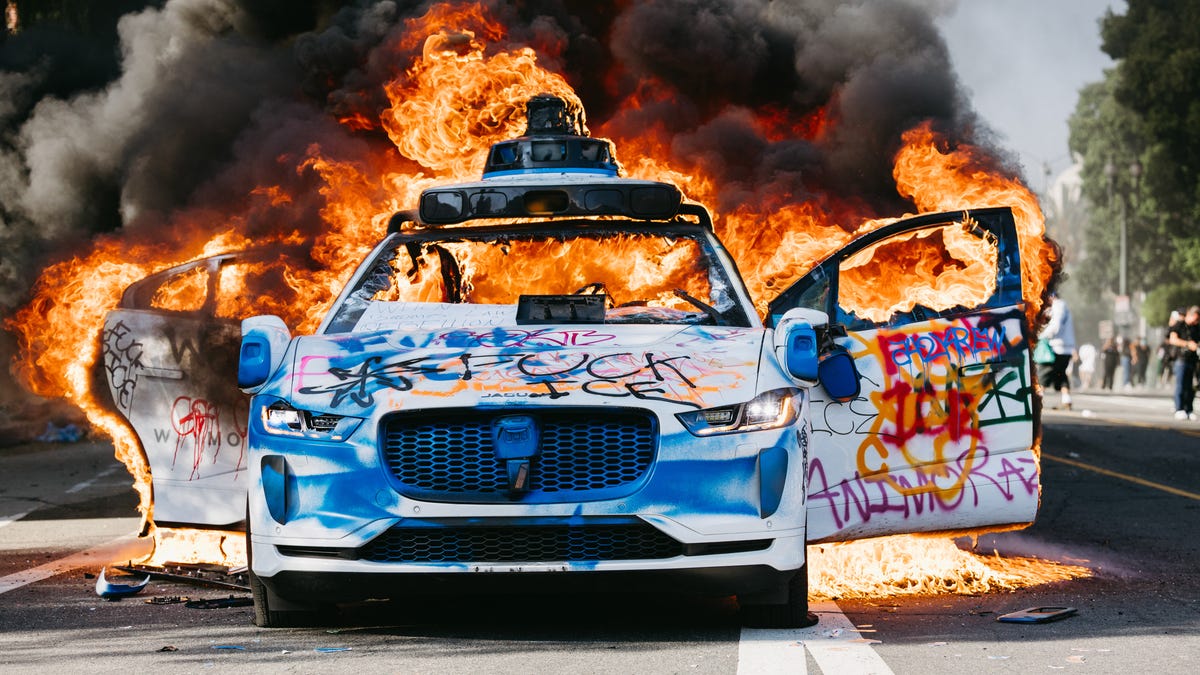Waymo taxis were set on fire during L.A. protests. It’s unclear whether they were called or if protesters simply took advantage of their presence

Protesters set Waymo cars on fire in Los Angeles anti-ICE protests
Footage showed flames and thick smoke as demonstrators set Waymo cars on fire during an anti-ICE protest in Los Angeles on Sunday afternoon.
Multiple Waymo self-driving robotaxis were set on fire in Los Angeles during protests there. Other cars were also put to the torch but the Waymos have garnered special interest, partially because they’re something new on the scene and partially because as electric vehicles, they raise different and specific concerns if their batteries burn.
Here’s what we know and what experts worry about.
How many Waymos burned?
From social media and photos, it appears that at least five Waymo self-driving robotaxis were set on fire on Sunday, June 8 amidst immigration protests in downtown Los Angeles.
Protesters smashed windows on the cars – all Jaguar I-PACE electric SUVs – as well as spray painting them with anti-ICE and anti-Trump slogans. Some were also set on fire.
The burning cars, whose base sticker price is $73,000, according to Car and Driver, sent plumes of thick black smoke billowing into the blue Los Angeles sky, making for stunning photos that have figured prominently in many media feeds about the protests.
What’s Waymo doing about the attacks on its cars?
Waymo has suspended service to the affected area of downtown Los Angeles.
A Waymo spokesperson told USA TODAY on Monday morning, June 9, the company has removed its vehicles from downtown Los Angeles and is currently not serving the area “out of an abundance of caution.”
The spokesperson said the company is still operating in Los Angeles, which covers 500 square miles, and is working in coordination with the Los Angeles Police Department.
In San Francisco, where three separate protests are planned for Monday, June 9, Waymo told USA TODAY while the company was still operating and serving riders in San Francisco, it is currently limiting trips in certain areas where protesters may be gathering.
What other cities have Waymos?
Waymo are available for rides in Austin, Phoenix, Los Angeles, parts of Silicon Valley and all of San Francisco. They’re expected to start in Atlanta, Miami and Washington in 2026. In April the company announced its first foreign venture, with testing beginning in Tokyo.
According to the company, more than 250,000 trips a week are taken in its driverless robotaxis.
Waymo is owned by Google’s parent company, Alphabet.
Are people targeting Waymos specifically?
It’s not clear if the Los Angeles protesters were specifically targeting Waymos or if the cars just happened to wander into the area and because they have no drivers, they were perceived as more vulnerable or they simply didn’t know to drive away.
The Waymos that burned all appeared to be empty, meaning no passengers were potentially at risk.
There have been suggestions online that protesters might have called Waymos to the area specifically to set them on fire. However that would mean Waymo would know the name and contact info of the people who’d called them, making the scenario less likely though certainly not impossible. Waymo would not say how its cars came to be in the area.
There have also been suggestions that the Waymos were targeted because they are festooned with cameras, meaning they might be used to identify protesters engaging in illegal activity. However many modern cars are equipped with cameras, so Waymos aren’t that different from most newer vehicles on the road.
In cities where Waymos are available, which include San Francisco, Los Angeles, Austin and Phoenix, the cars are very much like human-driven taxis. They’re a frequent sight as they drive around on their way to pick up passengers, or to park as they wait for their next ride request.
That means they’re often wandering around on city streets, especially in popular and busy areas – like downtown Los Angeles. So it’s quite possible the Waymos that were attacked were just going about their business and happened to be in the wrong place at the wrong time.
It’s also true that Waymos are very conservative in their driving habits and won’t drive threateningly if surrounded by people. So while a human driver might rev their motor or honk or drive aggressively to get out of a potentially dangerous situation, a Waymo would just calmly try to go on its way – making it an easy target.
What happens when an EV burns?
Electric vehicle fires can burn hotter and more intensely than gasoline-fueled cars, if their batteries catch fire. This can happen if they are crashed or if their batteries are infiltrated with saltwater, as can happen to cars nears the coast during hurricanes and flooding events.
If an electric vehicle’s battery is damaged by a collision or water intrusion, a short circuit can occur, which causes the cell to discharge energy and heat up. This can lead to an event called “thermal runaway,” in which the heat propagates from one cell to the next, causing them to burn.
Heat generated from a fire, thermal runaway of an adjacent cell, or shorting of the battery can melt the porous membrane between the battery’s cathode and anode, causing this cell to go into thermal runaway. The heat causes the cell to vent flammable gas, which can ignite and catch fire, which can cause a chain reaction.
Is a burning car a health hazard?
There are important distinctions between electric vehicle (EV) fires and traditional gasoline-powered vehicle fires, both in terms of combustion characteristics and potential health hazards, said Dr. Alberto Caban-Martinez, deputy director of the Sylvester Firefighter Cancer Initiative at the University of Miami Miller School of Medicine.
EV fires can release gases such as hydrogen fluoride, carbon monoxide, volatile organic compounds, and metal-based particulates.
“These emissions differ in composition from those generated by gasoline combustion, which primarily include carbon monoxide, benzene, and other hydrocarbons,” he said.
The health concerns from EV fires arise for anyone nearby, particularly bystanders downwind of the smoke plume who may inhale toxic combustion byproducts, Caban-Martinez said.
But firefighters are at special risk due to the frequency and intensity of their exposure to EV fires.
“Firefighters often work in close proximity to the fire, are involved in prolonged suppression and overhaul tasks, and may experience cumulative exposure over the course of their careers. Repeated exposures, even at low doses to hazardous substances released during EV fires can increase the risk of long-term health effects, including respiratory disease and cancer,” Caban-Martinez said.
Putting out a fire in an electric vehicle requires different techniques
If an electric vehicle’s battery catches fire, different firefighting techniques can be required to quench it. Firefighters are trained on these techniques and the National Fire Protection Association offers emergency response guides to most alternative fuel vehicles.
Today most EVs are built with what are known as “cut loops” or “first responder loops” that allow firefighters and first responders to easily cut and disconnect the high-voltage system outside of the high voltage battery, to reduce the risk of electric shock and possible fire. Note: this can only be done safely by trained professionals with the appropriate tools and gear.
EV fires are more difficult to put out than ones in gasoline-powered cars and require different firefighting techniques, which firefighters are trained on.
The biggest difference is that an EV battery fire cannot be put out with the type of firefighting foam used to smother other fires. If an EV battery is on fire, it does not require oxygen to burn because it is self-sustaining, so the foam cannot stop the fire.
Instead, the battery must be cooled to stop the fire and end thermal runaway. One technique is to use special “pancake nozzles” that can slide underneath the vehicle to spray water on the bottom of the battery box, though these require large amounts of water.









